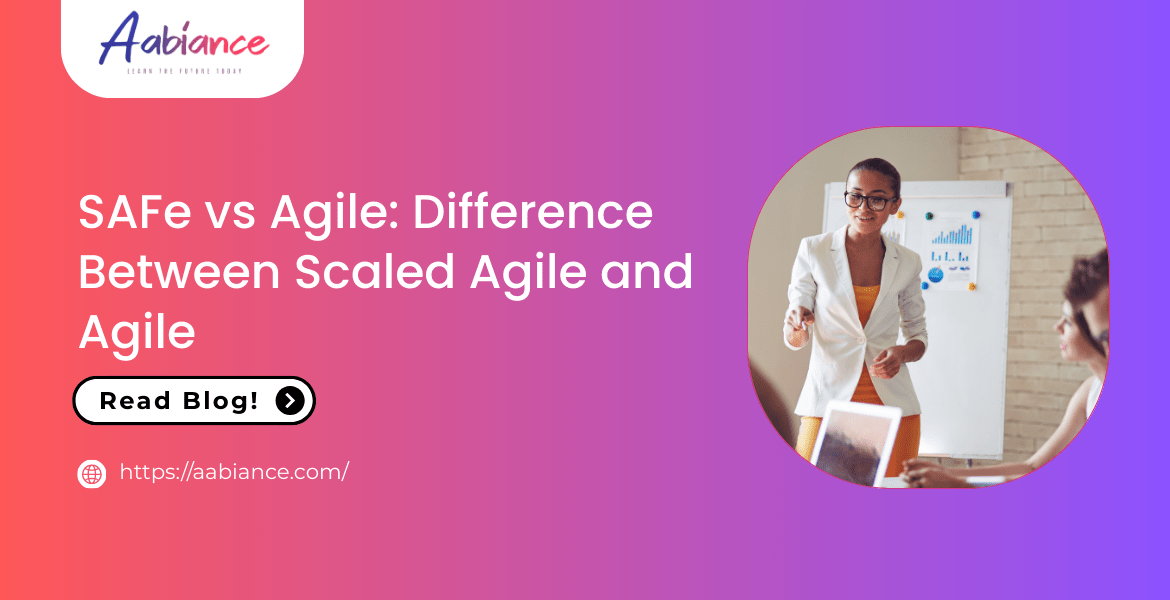SAFe vs Agile: Difference Between Scaled Agile and Agile
August 8, 2025 2025-08-28 18:51SAFe vs Agile: Difference Between Scaled Agile and Agile

SAFe vs Agile: Difference Between Scaled Agile and Agile
In today’s fast-moving business environment, organizations are under constant pressure to deliver high-quality products faster and more efficiently. Agile methodologies have helped teams become more adaptive, collaborative, and customer-focused. But as organizations grow and projects scale across departments, traditional Agile practices sometimes fall short. This is where SAFe, or Scaled Agile Framework, comes in.
So, what exactly is the difference between SAFe and Agile? If you’re an Agile Scrum Master, preparing for advanced Scrum Master training, or exploring the world of Agile project management, this blog will clarify the key differences between Agile and SAFe, and help you understand which one is right for your organization.
We’ll also touch on Scrum Master certification cost, training locations like Scrum Master certification Pune, and job trends such as Scrum Master jobs in Chennai.
What is Agile?
Agile is a mindset and methodology focused on iterative development, continuous improvement, and customer collaboration. Agile encourages teams to deliver small, working pieces of software regularly rather than waiting months for a large release. It thrives in dynamic, fast-paced environments where customer needs often change.
Agile methodologies include:
- Scrum
- Kanban
- Extreme Programming (XP)
- Lean Software Development
Scrum, the most popular Agile framework, involves roles like Product Owner, Development Team, and Scrum Master. Those who pursue Scrum Master certification learn how to facilitate the Scrum process, manage team dynamics, and remove impediments to progress.
What is SAFe (Scaled Agile Framework)?
SAFe (Scaled Agile Framework) is a structured approach to scaling Agile across large enterprises with multiple teams working on the same product or within the same portfolio. It provides a set of principles, roles, and practices that enable organizations to implement Agile at scale while maintaining alignment, collaboration, and governance.
SAFe builds on Agile and Lean principles but introduces several additional layers:
- Team level
- Program level
- Large solution level
- Portfolio level
It offers guidance on how to handle budgeting, architecture, compliance, and coordination across large teams and departments.
Key Differences Between Agile and SAFe
Let’s break down the major differences between Agile and SAFe across several dimensions:
- Scale of Application
- Agile is best suited for small, cross-functional teams working independently.
- SAFe is designed for large organizations where multiple Agile teams must collaborate to deliver complex, large-scale solutions.
- Structure and Roles
- Agile roles are relatively simple: Scrum Master, Product Owner, and Development Team.
- SAFe adds more layers, including roles like Release Train Engineer (RTE), Solution Architect, Product Manager, and more.
If you’re already working as an Agile Scrum Master and want to work in an enterprise setting, advanced Scrum Master training or SAFe certification can prepare you for broader responsibilities.
- Governance
- Agile promotes autonomy within teams, with minimal hierarchy.
- SAFe introduces structured governance and strategic alignment through the Portfolio layer.
This structured governance is helpful in regulated industries where compliance, documentation, and strategic planning are essential.
- Planning and Execution
- Agile typically uses two-week sprints and keeps planning light and flexible.
- SAFe operates on Program Increments (PIs), usually 8-12 weeks long, and uses PI Planning for cross-team coordination.
PI Planning is a key event in SAFe that helps synchronize the efforts of multiple Agile teams.
- Team Collaboration
- Agile teams usually operate independently with their own backlogs.
- SAFe teams collaborate under a single Agile Release Train (ART), aligning their goals and timelines.
This level of coordination is essential for delivering integrated products in large organizations.
Choosing Between Agile and SAFe
Use Agile if:
- Your organization is small or medium-sized.
- You want to promote a culture of autonomy and quick decision-making.
- Your product can be developed by a single team or a few small teams.
Use SAFe if:
- You are part of a large enterprise with multiple Agile teams.
- Your organization needs more coordination, strategy alignment, and governance.
- You’re working on large-scale systems with complex interdependencies.
Many professionals start with Agile and later move into SAFe environments as they join larger enterprises. This often leads them to pursue advanced Scrum Master training or SAFe Scrum Master certifications.
Scrum Master Certification: Cost and Training Options
As interest in Agile and SAFe grows, so does the demand for certified Scrum Masters. Whether you’re just starting or upgrading your skills, getting certified is a great career move.
- Scrum Master Certification Cost
The cost of a Scrum Master certification depends on the provider and the level of certification. Here’s a general idea:
- Certified ScrumMaster® (CSM): ₹20,000 to ₹30,000 INR (~$250–$350 USD)
- Advanced Certified ScrumMaster® (A-CSM): ₹30,000 to ₹45,000 INR (~$400–$550 USD)
- SAFe Scrum Master (SSM): ₹35,000 to ₹50,000 INR (~$450–$600 USD)
These costs usually include two days of training, exam fees, and course materials.
- Scrum Master Certification Pune
Pune is one of the top cities in India for Agile training and certifications. With its rapidly growing IT sector, many professionals are turning to Scrum Master training to advance their careers. One of the trusted providers offering quality Scrum Master certification training in Pune is:
- Aabiance Technology
Aabiance Technology offers both in-person and online courses designed to help professionals gain practical knowledge, prepare for certification exams, and succeed in Agile roles. Whether you’re aiming for entry-level certification or advanced Scrum Master training, Aabiance provides structured programs tailored to industry needs.
If you’re based in Pune or nearby, attending a classroom session can give you a better learning experience and networking opportunities.
Scrum Master Jobs in Chennai
Chennai has emerged as a major hub for IT services, product development, and Agile adoption. As more companies embrace SAFe and Agile frameworks, there’s a noticeable rise in Scrum Master jobs in Chennai.
Popular Industries Hiring Scrum Masters in Chennai:
- IT Services & Consulting
- BFSI (Banking, Financial Services, and Insurance)
- Healthcare IT
- Product-based companies
- Startups transitioning to Agile
Many companies prefer candidates who not only have a Scrum Master certification but also practical experience with SAFe or other scaled Agile frameworks.
Future of Agile and SAFe
Agile isn’t going anywhere. It continues to evolve and adapt to the needs of modern businesses. However, as organizations scale and become more complex, the demand for frameworks like SAFe is growing.
The hybrid world of Agile + SAFe creates new roles, responsibilities, and career opportunities. Professionals who understand both small-team Agile dynamics and enterprise-level scaling have a major advantage in today’s job market.
Final Thoughts
Choosing between Agile and SAFe depends on your organization’s size, structure, and goals. While Agile offers speed and flexibility for smaller teams, SAFe brings structure and coordination to complex, large-scale environments.
If you’re an Agile Scrum Master looking to expand your skills, advanced Scrum Master training can open the door to SAFe roles and certifications. Whether you’re exploring options in Scrum Master certification Pune, budgeting for your Scrum Master certification cost, or targeting Scrum Master jobs in Chennai, staying up to date with both Agile and SAFe will boost your career significantly.
Both methodologies serve different purposes, and when used appropriately, they lead to better product delivery, improved collaboration, and business agility.







